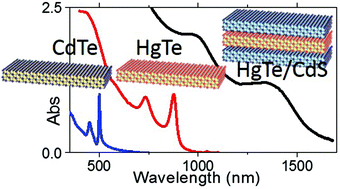Impact of dimensionality and confinement on the electronic properties of mercury chalcogenide nanocrystals†
Abstract
We demonstrate the growth of 2D nanoplatelets (NPLs) made of a HgTe/CdS heterostructure, with an optical absorption reaching the shortwave infrared range. The material is an interesting platform to investigate the effect of dimensionality (0D vs. 2D) and confinement on the electronic spectrum and carrier dynamics in colloidal materials. We bring consistent evidence for the p-type nature of this material from transport and photoemission measurements. The majority carrier dynamics probed using pump–probe photoemission is found to be mostly dependent on the presence of a confinement barrier at the surface rather than on the material dimensionality. The minority carrier, on the other hand, is strongly affected by the material shape showing a longer lived minority carrier in 2D NPLs compared to their 0D equivalent with a similar band gap. Finally, we test the potential of this material for photodetection in the short-wave infrared range (SWIR) and show that fast photoresponse and detectivity reaching 109 Jones at room temperature can be achieved.



 Please wait while we load your content...
Please wait while we load your content...